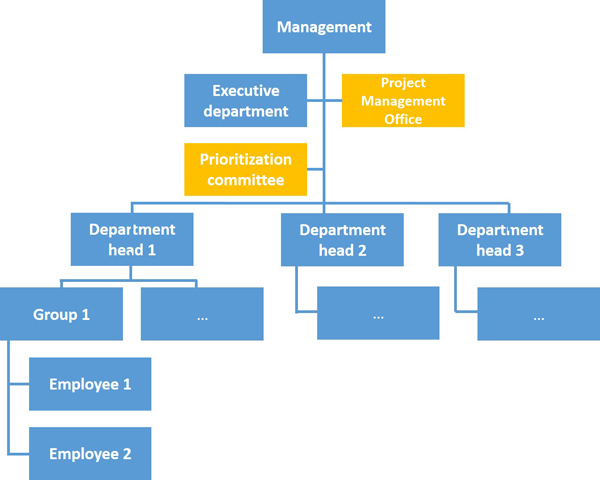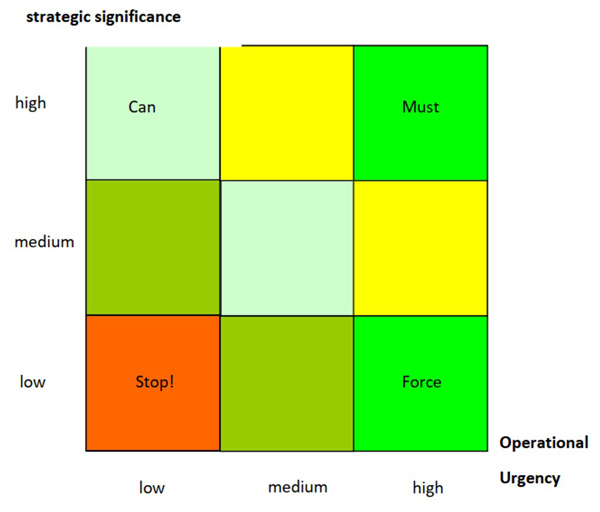Multi-Project Management – Task in the area of conflict between line and project
Goals and tasks of multi-project management
As a rule, projects should contribute to the achievement of corporate goals. The aim of multi-project management is to make the “right” selection of effective projects and at the same time to use the resources to be deployed efficiently (economically).
Portfolio management thus directly pursues (strategic) corporate objectives and protects investments.
The tasks of multi-project management go far beyond the “mere administration of projects”! In many organizations, special committees have been created for these tasks. These committees are usually supported by a project management office.
Plans and projects are evaluated, prioritized, and re-prioritized according to uniform and transparent criteria. The decisive factor is the respective contribution to achieving the organizational goals.
Tasks in detail:
- Project selection and prioritization according to consistent criteria and strategic aspects or corporate/organizational objectives
- Regular and unscheduled evaluation of plans and projects (re-prioritization)
- Coordination of projects so that the overall result of all projects is optimum concerning organizational objectives
- Coordination of organizational goals and project goals
- Information and consultation with the management
- Comprehensive, strategic project management (project portfolio management)
- Comprehensive project controlling
- Scheduling and capacity planning (staff deployment planning, regulation of access to mutual resources for several projects)
- Comprehensive communication and reporting
- Comprehensive risk management
Organizational Structure and Process Organization
Implementing multi-project management will have a significant impact on the organization’s structure and processes. Of course, it should be executed as a project (organizational development and change management).
The line organization (the regular structure of the company) and the project organization (the temporary structure created for specific projects) need to be involved. The following diagram gives a first idea of the complexity:

Two new subjects were created in this organizational chart:
- The project management office
- And the prioritization committee
The project management office (PMO) – should be understood as a cross-project service center for projects and lines. This staff unit has an overview of all projects carried out throughout the company, including those in the planning stage (projects). Depending on the size of the company, it may make sense to establish a central PMO with additional sub-organizations. The PMO can also be assigned to individual projects.
The PMO works closely with the prioritization committee. The main responsibility of this committee is to give priority to all company plans and projects that utilize company resources in any way, both currently and in the future.

The project organization is still determined by the importance and complexity of the projects. Thus, not every project has a steering committee; similarly, the project organization structure is also decided according to similar considerations.
Line and projects compete for resources. It is a management task to lay the foundations for an “appropriate balance” between the parties involved. In addition, many structural tasks are similar in the various projects. For example Unified Project Management, Quality Management, Communication & Information Management, and Change Management.
That is why it primarily depends on the following:
- Realize the “right” projects “correctly”
- Managing resources in a meaningful and targeted manner,
- Discover and use synergies and
- Making the experience available
This central task of multi-project management is distributed among various organizational units or centralized in the staff units and committees addressed.
Depending on the size of the organization, the following structure is conceivable:

In contrast to portfolios, programs have time limitations. In this case, projects with the same orientation are grouped to form programs. However, the chosen organizational form should make a contribution to the corporate goals at every level.
Stakeholders of the project portfolio

Portfolio management: prioritization
Portfolio management is an important ongoing task. Projects are seen as an instrument for achieving organizational goals. Thus, steering the available resources is important for the organization’s success.
Process description – an example process
The status of a project influences the priority of a project within the project portfolio. Therefore, a regular project status report should be prepared for all projects already in progress! This project status report is prepared by the project manager (with the participation of the project team) for the client or the steering committee and should be part of the standard procedure.
There is a differentiation between projects and undertakings. A project refers to a possible endeavor that is still being evaluated, meaning that it is being assessed whether it should be authorized and initiated as a project.
The project assignment process has been completed for a particular project, which has been approved and transitioned from an undertaking to a project in its lifecycle. Nevertheless, it is important to consider projects in resource planning and prioritize them based on the level of resource commitment or intensity required.
Process Description of Project

Since the evaluation is carried out at a time when only imprecise information about the project is available, the effort estimate (and the resulting profitability calculation including extrapolation of the required resources) could be correspondingly imprecise.
Although this is true for every project, it is not a crucial factor in assessing or contrasting them. It is important to acknowledge that the projected budget and resources may differ from the actual ones used later on. Therefore, it is necessary to choose the appropriate level of detail for planning or estimating the effort. However, this does not exempt project management from monitoring the actual expenses and promptly informing the client of any potential budget excesses.
The process description of project prioritization differs only slightly from the procedure for projects.
Process Description of Project Prioritization

Project Portfolio
The project portfolio can also be displayed graphically:

According to the above presentation, projects are evaluated under the following aspects
- Strategic importance (long-term perspective)
Significance within the IT framework, quality improvement in the completion of specialist tasks, acceleration of workflows, processes
- Operational urgency
The urgency of replacing the old system, compliance with administrative regulations and laws…
- Economic efficiency
Development costs and development benefits, operating costs and operating benefits
Net present value method
Determination of present values and net present value
K0= ∑𝑛 𝑡=0 (𝐸𝑡 – 𝐴)𝑞 – 𝑡

- External Effects
Removing urgency from the external customer’s perspective, ensuring simplicity for customers, and enhancing clarity and ability to track progress…
Tool support
To support the prioritization process and the associated follow-up activities, such as cross-project staff (Cross-project staff refers to employees or team members who work on multiple projects within an organization) scheduling, there is a wide range of project management tools available in project practice.
What is most important in the selection process is that the tools support the desired process – and that the organization adapts to the used tool!
Like all tools, they require user competence for their meaningful use. (Experience and Qualification)
A fool with a tool is still a fool
Change management is absolutely necessary

The introduction or change of a software or any kind of intervention in the processes of an organization always initiates a change process. This process should be managed proactively: Change management.
People create business processes for the benefit of other people. These processes aim to promote regulatory cooperation, ensuring that they can be replicated and improved over time to enhance efficiency and effectiveness.
A process model is also based on the assumption that the process is lived by the employees according to the description. This does not correspond to reality!
Individuals possess unique qualities, including their strengths, worries, and anxieties. Their upbringing has influenced them to adapt to their current work setting and procedures, resulting in a sense of stability and safety.
The implementation of multi-project management can cause a permanent disturbance in the situation and disrupt the equilibrium that may have been achieved. The success of the organizational change will depend on how employees react to this disruption, whether they were directly affected or not. It’s like throwing a stone into water, creating waves that can either be accepted or resisted. Furthermore, the time needed for individuals to adjust to the new environment will vary, including when they start and finish adapting.
The process of change should be carried out at pace, decisively, and consistently. The period of the transformation process (equivalent to an increased burden on employees) should be minimized. However, participation in the redesign of the processes is important for acceptance. It, therefore, takes time for the organizational change to be accepted and lived – in other words, for the desired level (successful learning) to be reached.
Key success factors
- To summarize, here is a brief overview of the key success factors:
- Successful communication
- Definite and lived roles and responsibilities
- Definite and lived processes
- Coordinated action
- Competent employee
- Adequate process organization
- The right mindset
- Useful infrastructure (tools…)
- At all organizational levels
This is the penultimate part of our series on portfolio management. The last article will deal with the current situation in companies and show possible solutions to the shortage of resources. A topic that will certainly affect many of you at the moment.